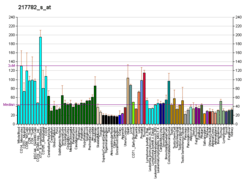GPS1
COP9 signalosome complex subunit 1 is a protein that in humans is encoded by the GPS1 gene.[5][6]
This gene is known to suppress G-protein and mitogen-activated signal transduction in mammalian cells. The encoded protein shares significant similarity with Arabidopsis FUS6, which is a regulator of light-mediated signal transduction in plant cells. Two alternatively spliced transcript variants encoding different isoforms have been found for this gene.[6]
References
- 1 2 3 GRCh38: Ensembl release 89: ENSG00000169727 - Ensembl, May 2017
- 1 2 3 GRCm38: Ensembl release 89: ENSMUSG00000025156 - Ensembl, May 2017
- ↑ "Human PubMed Reference:".
- ↑ "Mouse PubMed Reference:".
- ↑ Seeger M, Kraft R, Ferrell K, Bech-Otschir D, Dumdey R, Schade R, Gordon C, Naumann M, Dubiel W (Apr 1998). "A novel protein complex involved in signal transduction possessing similarities to 26S proteasome subunits". FASEB J. 12 (6): 469–78. PMID 9535219.
- 1 2 "Entrez Gene: GPS1 G protein pathway suppressor 1".
Further reading
- Wolf DA, Zhou C, Wee S (2004). "The COP9 signalosome: an assembly and maintenance platform for cullin ubiquitin ligases?". Nat. Cell Biol. 5 (12): 1029–33. doi:10.1038/ncb1203-1029. PMID 14647295.
- Maruyama K, Sugano S (1994). "Oligo-capping: a simple method to replace the cap structure of eukaryotic mRNAs with oligoribonucleotides". Gene. 138 (1–2): 171–4. doi:10.1016/0378-1119(94)90802-8. PMID 8125298.
- Spain BH, Bowdish KS, Pacal AR, et al. (1997). "Two human cDNAs, including a homolog of Arabidopsis FUS6 (COP11), suppress G-protein- and mitogen-activated protein kinase-mediated signal transduction in yeast and mammalian cells". Mol. Cell. Biol. 16 (12): 6698–706. doi:10.1128/mcb.16.12.6698. PMC 231672. PMID 8943324.
- Suzuki Y, Yoshitomo-Nakagawa K, Maruyama K, et al. (1997). "Construction and characterization of a full length-enriched and a 5'-end-enriched cDNA library". Gene. 200 (1–2): 149–56. doi:10.1016/S0378-1119(97)00411-3. PMID 9373149.
- Wei N, Tsuge T, Serino G, et al. (1998). "The COP9 complex is conserved between plants and mammals and is related to the 26S proteasome regulatory complex". Curr. Biol. 8 (16): 919–22. doi:10.1016/S0960-9822(07)00372-7. PMID 9707402.
- Tsuge T, Matsui M, Wei N (2001). "The subunit 1 of the COP9 signalosome suppresses gene expression through its N-terminal domain and incorporates into the complex through the PCI domain". J. Mol. Biol. 305 (1): 1–9. doi:10.1006/jmbi.2000.4288. PMID 11114242.
- Bech-Otschir D, Kraft R, Huang X, et al. (2001). "COP9 signalosome-specific phosphorylation targets p53 to degradation by the ubiquitin system". EMBO J. 20 (7): 1630–9. doi:10.1093/emboj/20.7.1630. PMC 145508. PMID 11285227.
- Lyapina S, Cope G, Shevchenko A, et al. (2001). "Promotion of NEDD-CUL1 conjugate cleavage by COP9 signalosome". Science. 292 (5520): 1382–5. doi:10.1126/science.1059780. PMID 11337588.
- Hoareau Alves K, Bochard V, Réty S, Jalinot P (2002). "Association of the mammalian proto-oncoprotein Int-6 with the three protein complexes eIF3, COP9 signalosome and 26S proteasome". FEBS Lett. 527 (1–3): 15–21. doi:10.1016/S0014-5793(02)03147-2. PMID 12220626.
- Sun Y, Wilson MP, Majerus PW (2003). "Inositol 1,3,4-trisphosphate 5/6-kinase associates with the COP9 signalosome by binding to CSN1". J. Biol. Chem. 277 (48): 45759–64. doi:10.1074/jbc.M208709200. PMID 12324474.
- Strausberg RL, Feingold EA, Grouse LH, et al. (2003). "Generation and initial analysis of more than 15,000 full-length human and mouse cDNA sequences". Proc. Natl. Acad. Sci. U.S.A. 99 (26): 16899–903. doi:10.1073/pnas.242603899. PMC 139241. PMID 12477932.
- Serino G, Su H, Peng Z, et al. (2003). "Characterization of the Last Subunit of the Arabidopsis COP9 Signalosome: Implications for the Overall Structure and Origin of the Complex". Plant Cell. 15 (3): 719–31. doi:10.1105/tpc.009092. PMC 150025. PMID 12615944.
- Uhle S, Medalia O, Waldron R, et al. (2003). "Protein kinase CK2 and protein kinase D are associated with the COP9 signalosome". EMBO J. 22 (6): 1302–12. doi:10.1093/emboj/cdg127. PMC 151059. PMID 12628923.
- Groisman R, Polanowska J, Kuraoka I, et al. (2003). "The ubiquitin ligase activity in the DDB2 and CSA complexes is differentially regulated by the COP9 signalosome in response to DNA damage". Cell. 113 (3): 357–67. doi:10.1016/S0092-8674(03)00316-7. PMID 12732143.
- Ota T, Suzuki Y, Nishikawa T, et al. (2004). "Complete sequencing and characterization of 21,243 full-length human cDNAs". Nat. Genet. 36 (1): 40–5. doi:10.1038/ng1285. PMID 14702039.
- Wang Y, Lu C, Wei H, et al. (2004). "Hepatopoietin interacts directly with COP9 signalosome and regulates AP-1 activity". FEBS Lett. 572 (1–3): 85–91. doi:10.1016/j.febslet.2004.07.012. PMID 15304329.
- Gerhard DS, Wagner L, Feingold EA, et al. (2004). "The Status, Quality, and Expansion of the NIH Full-Length cDNA Project: The Mammalian Gene Collection (MGC)". Genome Res. 14 (10B): 2121–7. doi:10.1101/gr.2596504. PMC 528928. PMID 15489334.
- Beausoleil SA, Villén J, Gerber SA, et al. (2006). "A probability-based approach for high-throughput protein phosphorylation analysis and site localization". Nat. Biotechnol. 24 (10): 1285–92. doi:10.1038/nbt1240. PMID 16964243.
This article is issued from
Wikipedia.
The text is licensed under Creative Commons - Attribution - Sharealike.
Additional terms may apply for the media files.




